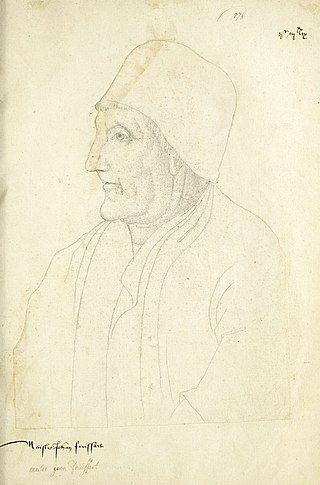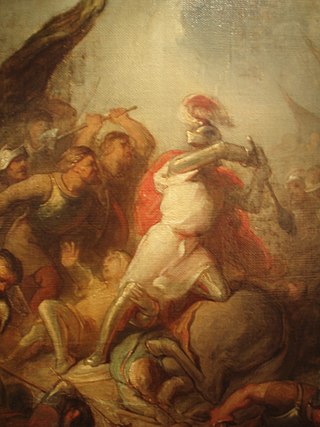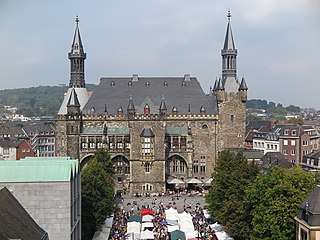Related Research Articles

Jean Froissart was a French-speaking medieval author and court historian from the Low Countries who wrote several works, including Chronicles and Meliador, a long Arthurian romance, and a large body of poetry, both short lyrical forms as well as longer narrative poems. For centuries, Froissart's Chronicles have been recognised as the chief expression of the chivalric revival of the 14th-century kingdoms of England, France and Scotland. His history is also an important source for the first half of the Hundred Years' War.

Sigebert of Gembloux was a medieval author, known mainly as a pro-Imperial historian of a universal chronicle, opposed to the expansive papacy of Gregory VII and Pascal II. Early in his life he became a monk in the Benedictine abbey of Gembloux.

Albert of Stade was a German monk, historian and poet.
The Medieval Chronicle Society is an international and interdisciplinary organization founded to facilitate the work of scholars interested in medieval annals and chronicles, or more generally medieval historiography. It was founded in 1999 and in February 2011 had 380 members.
Alberic of Trois-Fontaines was a medieval Cistercian chronicler who wrote in Latin. He was a monk of Trois-Fontaines Abbey in the diocese of Châlons-sur-Marne. He died after 1252. He wrote a chronicle describing world events from the Creation to the year 1241.

Emo of Friesland was a Frisian scholar and abbot who probably came from the region of Groningen, and the earliest foreign student studying at Oxford University whose name has survived. He wrote a Latin chronicle, later expanded by his successors Menco and Foltert into the Chronicon abbatum in Werum.
The Drenther Crusade was a military campaign launched against the inhabitants of Drenthe with the approval of the Papacy in 1228 and lasting until 1232. It was led by Willibrand, Bishop of Utrecht, commanding an army composed mostly of Frisian crusaders.

The Battle of Ane, was fought in 1227 between Otto II of Lippe, Bishop of Utrecht, and Rudolf II van Coevorden with his army of Drenths. The account of the battle comes from Quedam narracio de Groninghe de Trentis de Covordia et diversis aliis sub episcopis traiectensibus, a manuscript from the early 13th century.
The Abbey of Saint-Pierre-le-Vif was a Benedictine monastery just outside the walls of Sens, France, in the Archdiocese of Sens.

The County of Drenthe was a province of the Holy Roman Empire from 1046, and of the Dutch Republic from 1581 until 1795. It corresponds to the area west of the lower Ems, today the eponymous province of Drenthe in the Netherlands.
Bartolomea Riccoboni was a Dominican nun in the convent of Corpus Domini in Venice. She wrote a chronicle of the convent, and a necrology. She has been studied as a good example of the beginnings of women's writings in the late medieval mendicant orders. In addition to matters relating to her own convent, she records the events of the Papal Schism, in which she is an adherent of Gregory XII.
Chronicon Polono-Silesiacum or simply Chronicon Polonorum is a medieval Polish chronicle based on Wincenty Kadłubek's Chronica seu originale regum et principum Poloniae and the anonymous poem Carmen Mauri, with additional information on the history of Silesia. The date of its creation is uncertain and estimated at late 13th century, circa 1280 or at the turn of the century. The unknown author might have been a Cistercian monk from the Lubiąż Abbey.
Anonymus Leobiensis or Chronicon Leobiense is the conventional name for a Latin chronicle written in or shortly after 1345. It covers the years from the incarnation of Christ down to 1345 with an emphasis on the Holy Roman Empire and the Papacy. The author was certainly a cleric and a native of Leoben in the Duchy of Styria. He has been tentatively identified with Conrad of Leoben, a lecturer at the Dominican church in Vienna.
The Winchcombe Annals, sometimes known as the Later Winchcombe Annals, are a Latin chronicle compiled c. 1240 by an anonymous monk at the Benedictine abbey, Winchcombe Abbey.

Aachener Chronik is a town chronicle dated to the late 15th century.
The Deeds of the Bishops of Halberstadt is an anonymous Latin chronicle of the diocese of Halberstadt from its foundation in 780 down to 1209.
Berthold of Zwiefalten was a German Benedictine monk who thrice served as abbot of Zwiefalten Abbey and wrote its early history.
Johannes de Beke was a 14th-century Dutch priest and historian. He was probably a monk of Egmond Abbey. In 1346, he wrote a Latin Chronographia of the County of Holland and Diocese of Utrecht from the time of the Roman Empire down to his time. He dedicated it to Bishop Jan van Arkel and Count William I. His stated aim was to preserve the peace between counts and bishops by demonstrating the common origin and shared history of their territories.
Adelbert of Heidenheim was the abbot of the Benedictine monastery in Heidenheim, active in the 12th century. He wrote a biography of Winibald, titled Chronicon S. Wunnibaldi, also known as the Relatio from the title given to the earliest printed edition by Jakob Gretser, alongside a brief report on the history of the monastery that was published sometime between 1155 and 1160.
The Annales Tiliani are an anonymous set of Latin annals from the Frankish kingdom, covering the years 708–807. They are considered minor annals.
References
- 1 2 Justine Smithuis (2016), "Quaedam narracio [de Groninghe, de Thrente, de Covordia et de diversis aliis sub diversis episcopis Traiectensibus"], in Graeme Dunphy and Cristian Bratu (eds.), Encyclopedia of the Medieval Chronicle (Leiden: Brill). Consulted online on 7 November 2019.
- ↑ O. Vries (2015), "Frisonica libertas: Frisian Freedom as an Instance of Medieval Liberty", Journal of Medieval History, 41(2): 229–248. doi : 10.1080/03044181.2015.1034162
- ↑ Bas J. P. van Bavel (2010), "Rural Revolts and Structural Change in the Low Countries, Thirteenth – Early Fourteenth Centuries", in Richard Goddard; John Langdon; Miriam Müller (eds.), Survival and Discord in Medieval Society: Essays in Honour of Christopher Dyer (Turnhout: Brepols), pp. 249–268.
- ↑ Antheun Janse (2016), "Bella Campestria", in Graeme Dunphy and Cristian Bratu (eds.), Encyclopedia of the Medieval Chronicle (Leiden: Brill). Consulted online on 7 November 2019.